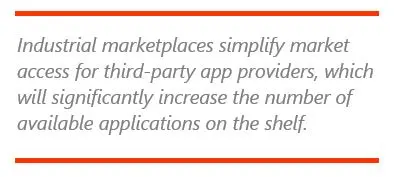

Keywords: Third-Party app providers, Marketplace, Industrial app store, Linux-based Operating Systems, ARC Advisory Group.
The industrial automation market has undergone a significant evolution in recent years due to the introduction of open protocols  and open-source applications. Application marketplaces have been commonplace in consumer segments for many years, with many smartphone users obtaining apps from third-party providers through Google Play or Apple’s App Store without realizing it. The revolution in the industrial automation market occurred several years ago when major suppliers introduced de-vices operating under the Linux-based operating system, making these devices universal and allowing software manufacturers to create cross-platform applications. Today, application marketplaces for industrial automation are gaining momentum. This ARC Insight explores the dynamics of third-party app providers.
and open-source applications. Application marketplaces have been commonplace in consumer segments for many years, with many smartphone users obtaining apps from third-party providers through Google Play or Apple’s App Store without realizing it. The revolution in the industrial automation market occurred several years ago when major suppliers introduced de-vices operating under the Linux-based operating system, making these devices universal and allowing software manufacturers to create cross-platform applications. Today, application marketplaces for industrial automation are gaining momentum. This ARC Insight explores the dynamics of third-party app providers.
Growing demand for programmers and developers has led to a rise in software development costs for companies. However, many small and medium-sized businesses cannot afford to hire an adequate number of developers due to the high costs. This is especially true for software developers who specialize in industrial applications in accordance with the IEC 61131-3 standard. The number of qualified programmers in this area is much smaller than for standard IT applications, which has long been a bottleneck for the industry. To address this issue, some companies turn to readymade applications from third-party app providers, which are widely available in marketplaces. These apps can be purchased or subscribed to, and typically come with a separate service for updates and customization. Using third-party applications can significantly speed up development and lead to cost savings. However, there are also potential downsides. One of the main disadvantages is that third-party applications are often standard solutions that may not always be suitable due to specific object or security requirements. It's important to recognize that third-party apps cannot yet cover the full range of tasks faced by customers.
Currently, the industrial application market is dominated by applications from PLC vendors. This is largely because most manufacturers themselves offer a variety of libraries, licenses, and proprietary applications that represent a significant portion of the market. Typical third-party apps include Communications, Control, Data Analysis, Remote Control and Monitoring, SCADA, HMI software and others. Most of these applications allow for seamless integration with PLCs and other third-party services. Marketplace applications are not typically standalone products, but rather are expertly designed for integrating industrial equipment with various services or platforms. As a result, the creators of these applications can increase the accessibility of their services and attract a wider user base.
ARC Advisory Group clients can view the complete report at the ARC Client Portal.
Please Contact Us if you would like to speak with the author.
Obtain more ARC In-depth Research at Market Analysis

